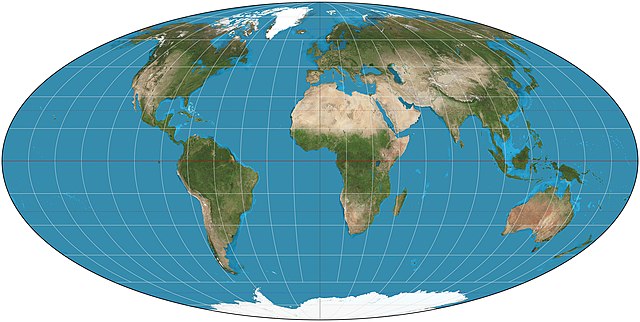Top Qs
Timeline
Chat
Perspective
Equal-area projection
Type of map projection From Wikipedia, the free encyclopedia
Remove ads
In cartography, an equivalent, authalic, or equal-area projection is a map projection that preserves relative area measure between any and all map regions. Equivalent projections are widely used for thematic maps showing scenario distribution such as population, farmland distribution, forested areas, and so forth, because an equal-area map does not change apparent density of the phenomenon being mapped.

By Gauss's Theorema Egregium, an equal-area projection cannot be conformal. This implies that an equal-area projection inevitably distorts shapes. Even though a point or points or a path or paths on a map might have no distortion, the greater the area of the region being mapped, the greater and more obvious the distortion of shapes inevitably becomes.

Remove ads
Description
Summarize
Perspective
In order for a map projection of the sphere to be equal-area, its generating formulae must meet this Cauchy-Riemann-like condition:[1]
where is constant throughout the map. Here, represents latitude; represents longitude; and and are the projected (planar) coordinates for a given coordinate pair.
For example, the sinusoidal projection is a very simple equal-area projection. Its generating formulae are:
where is the radius of the globe. Computing the partial derivatives,
and so
with taking the value of the constant .
For an equal-area map of the ellipsoid, the corresponding differential condition that must be met is:[1]
where is the eccentricity of the ellipsoid of revolution.
Statistical grid
This section needs expansion. You can help by adding to it. (April 2020) |
The term "statistical grid" refers to a discrete grid (global or local) of an equal-area surface representation, used for data visualization, geocode and statistical spatial analysis.[2][3][4][5][6]
Remove ads
List of equal-area projections
These are some projections that preserve area:
- Azimuthal
- Lambert azimuthal equal-area
- Wiechel (pseudoazimuthal)

- Conic
- Albers
- Lambert equal-area conic projection


- Cylindrical (with latitude of no distortion)
- Lambert cylindrical equal-area (0°)
- Behrmann (30°)
- Hobo–Dyer (37°30′)
- Gall–Peters (45°)

- Pseudocylindrical
- Other
- Eckert-Greifendorff
- McBryde-Thomas Flat-Polar Quartic Projection[7]
- Hammer
- Strebe 1995
- Snyder equal-area projection, used for geodesic grids.
Remove ads
See also
References
Wikiwand - on
Seamless Wikipedia browsing. On steroids.
Remove ads














